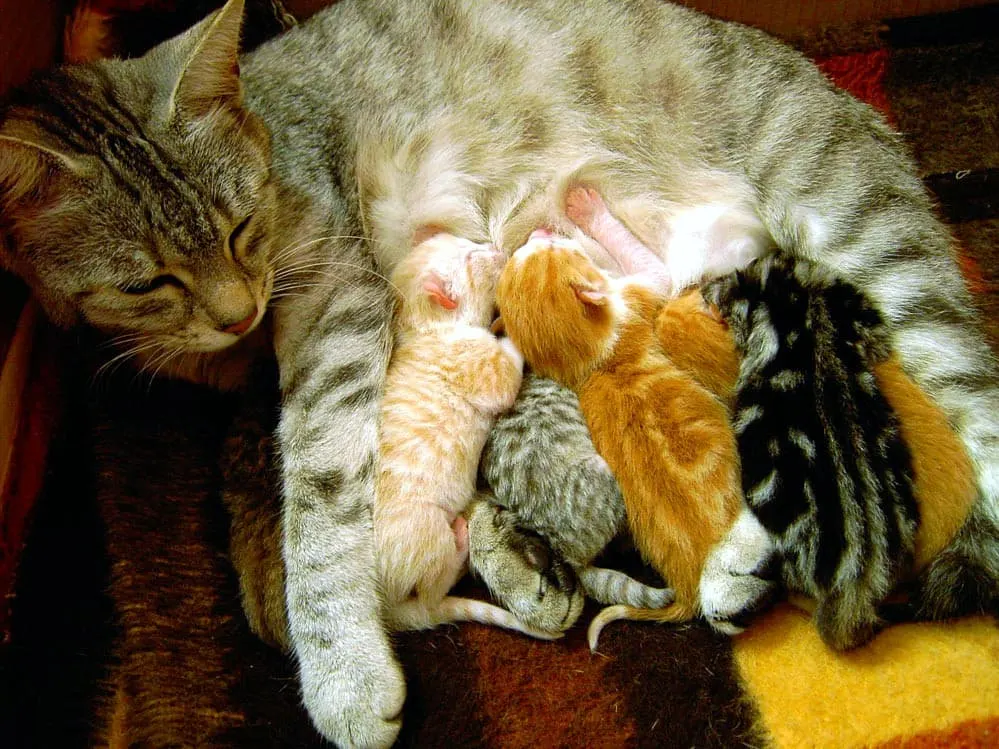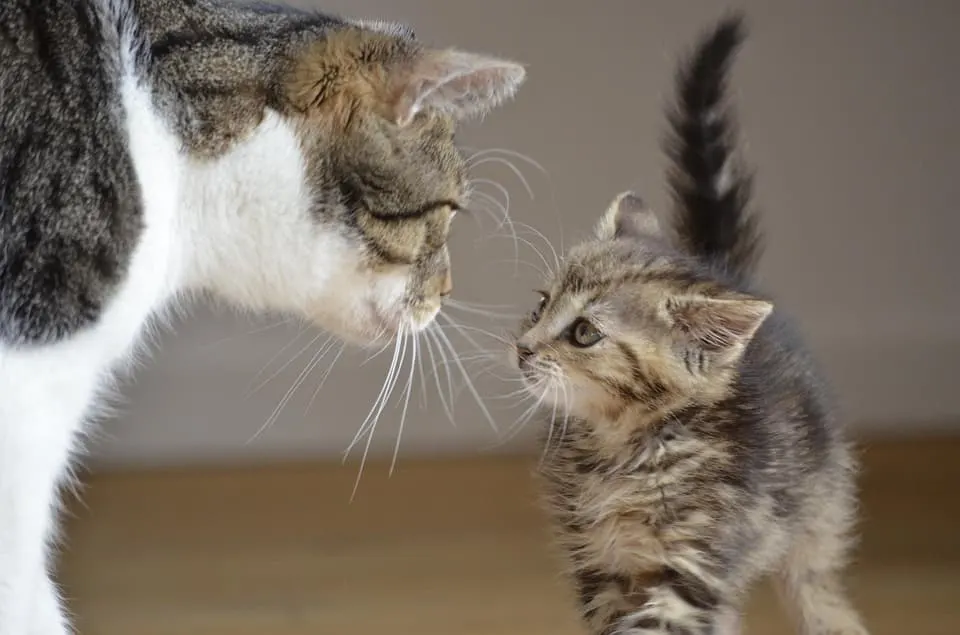Litter box training is an important step in your cat’s life, and if you’re lucky, there’s not that much “training” involved. C
ats have a natural instinct to use the the litter box; they just need the right encouragement, environment, and time to learn.
Teaching a kitten how to use the litter box and teaching a feral cat how to use the litter box are different.
Read on to find out all the steps you need to take to train your kitten or new, adult cat.

**WARNING** If you’re reading this article because you had a litter box trained cat that suddenly stopped using the litter box, this could be a sign of a serious infection.
In these cases, it is possible that your cat can’t hold it long enough to to make it to the litter box in time.
If your cat starts showing these symptoms, do not hesitate to contact your veterinarian.
Kittens that are still with their mom
Let’s start at the beginning of the litter box journey by talking about kittens.
If you have the mom cat and the kittens, make sure that you give mom her own litter box in addition to the kittens’ litter box. She’s been through a lot, and she deserves her own space to do her business.
If she’s sharing a liter box with her kittens, there’s also a chance the kittens could try to sneak under her to nurse while she’s relieving herself and get dirty.
Also, watching mom use the litter box will encourage this behavior in the kittens too!

5 Steps to Litter Box Train Your Kitten
According to the ASPCA, you can start litter box training kittens at about four weeks old. To litter box train your kitten(s), follow these steps:
1. Pick a good location. You don’t want to make your cat have to hunt for the litter box, so make it easy to get to. Put the litter box in a corner that’s out of the way and not near their food or their bed.
Despite the fact that cats don’t seem to respect our privacy when we’re in the bathroom, they like their privacy when doing their business.
Put the litter box in a corner that’s out of the way and not near their food or their bed.
2. Make it easy for them. The general rule for kittens is to make sure that there’s always a litter box within 10 feet of them.
If you have a very young kitten, it’s a good idea to confine them to one room when they are unsupervised so they are less likely to have an accident.
When they reach 8 weeks old, you can let them explore the rest of your home. At this point, you should have multiple litter box options for your kitten (especially a stubborn one that isn’t using their box).
Kittens will naturally look for a place with loose soil (in this case, litter) where they can relieve themselves and cover it, so you want to make it easy for them to get into the box and use it.
2. Use a shallow litter box. This goes along with making it easy for them. Kittens are little and learning, so they need a box that’s easy to get in and out of.
Make sure that the walls on the box aren’t too high for their little legs, and avoid using any kind of covered or automatic litter box to start with.
For kittens that are younger than 8 weeks old, you can even use a baking dish or the cardboard tray that wet food comes in.
3. Choose kitten-friendly litter. Kittens are a bit like human babies because they explore everything, and they use their mouth for a lot of it.
Avoid using litter that has any chemicals, fragrances, or clumping properties. Clumping litter is great for adult cats, but not for kittens who are still learning.
In addition, pick a fine, sand like litter as opposed to litter with larger particles to avoid a choking hazard.
Avoid automated litter boxes or litter boxes with covers until they have properly learned how to use their box.

4. Keep it extra clean. With kittens, especially, it’s important to clean the litter box throughout the day. Having a clean bathroom encourages them to keep using it.
If it’s dirty and undesirable, they will find other places to go, which will be less desirable for you.
5. Reward them for doing a good job. If your kitty uses the litter box properly, praise them for it.
Positive reinforcement goes a long way. If they make a mistake or miss the box, don’t scold. Just clean up the mess quickly and disinfect the area.
PREVENT MORE ACCIDENTS: Properly clean an accident area, otherwise your cat will smell their scent in that location and assume it’s okay to continue using the restroom there.
If you notice that your kitten is having accidents in the same location, consider moving the litter box to that location or disinfecting it again.
Older/Feral Cat Litter Box Training
If you have adopted an outside cat and made it an inside cat, the steps for teaching them how to use the litter box are similar to kittens.
1. Get multiple litter boxes. While the general rule is one litter box per cat, if you’re trying to train an a cat that has never used one before then it is better to have multiple so they have more options.
2. Pick a good location. Litter boxes needed to placed in private areas and in different rooms.
PRO TIP: If your cat wants more privacy than a corner provides, you can move a cat-safe plant in front of the box to make it more inviting and more like the outside.
Just be sure to put some tin foil strips on the top of the soil in the plant so kitty doesn’t use that as the litter box instead.
- LEARN MORE: 8 Suprisingly Common Plants That Are Toxic to Cats
- LEARN MORE: 9 Steps To Stop Your Cat From Scratching Furniture
3. If you have other cats, it will be easier to train your new cat. Cats learn from each other. If your new cat sees your pre-existing cats using the litter box, they’ll catch on.
However, you will find that cats do not like sharing litter boxes. Each kitty should have their own designated box. As stated earlier, the new cat needs plenty of boxes to choose from.

4. Avoid scented litter all together. Don’t worry, you can switch back to your favorite scented litter in the future.
Just avoid it until they are trained. Cats that live outside like to use the restroom in loose soil.
Scented litter is foreign and unfamiliar to cats that have never used it. Keep it unscented until they adjust.
PRO TIP: If your cat rejects the unscented litter, try potting soil and see if that works.
5. Avoid elaborate litter boxes and litter varieties. Just like with kittens, avoid covered or automatic litter boxes, and don’t use scented litter because it may deter them from using the box. You can always change this once they are trained.
6. Older cats might need shallow boxes. If you’re working with an older cat who may have some arthritis, be mindful of the height of the walls on the litter box.
Do what you need to to make it easy for your cat to get in and out of the litter box.

7. NEVER yell at your cat. If your cat has an accident, they are unaware of what that means to you.
They do however, associate your anger with them using the restroom and this only causes confusion and makes things worse.
You want using the litter box to be a natural and positive experience for your cat. Don’t get discouraged if they have an accident.
Clean it up, remove the scent, and don’t yell at them. When they do it right, give them some love or a treat and let them know they did a good job.
With both kittens and older cats, as long as you’re patient, encouraging, and you keep the box clean, you should be able to train them to use the litter box without much trouble.
They will naturally want to use it, and as long as you make it an inviting experience, they will get the hang of it.
The most important thing to remember is to pay attention to your kitty and take note of details in their behavior.
Each cat is unique, so a different approach might be necessary for different cats.
QUESTION: Did your cat need litter box training or did they start using it right away?
SURVEY: Do You Consider Cats Family?
Your opinion matters!



